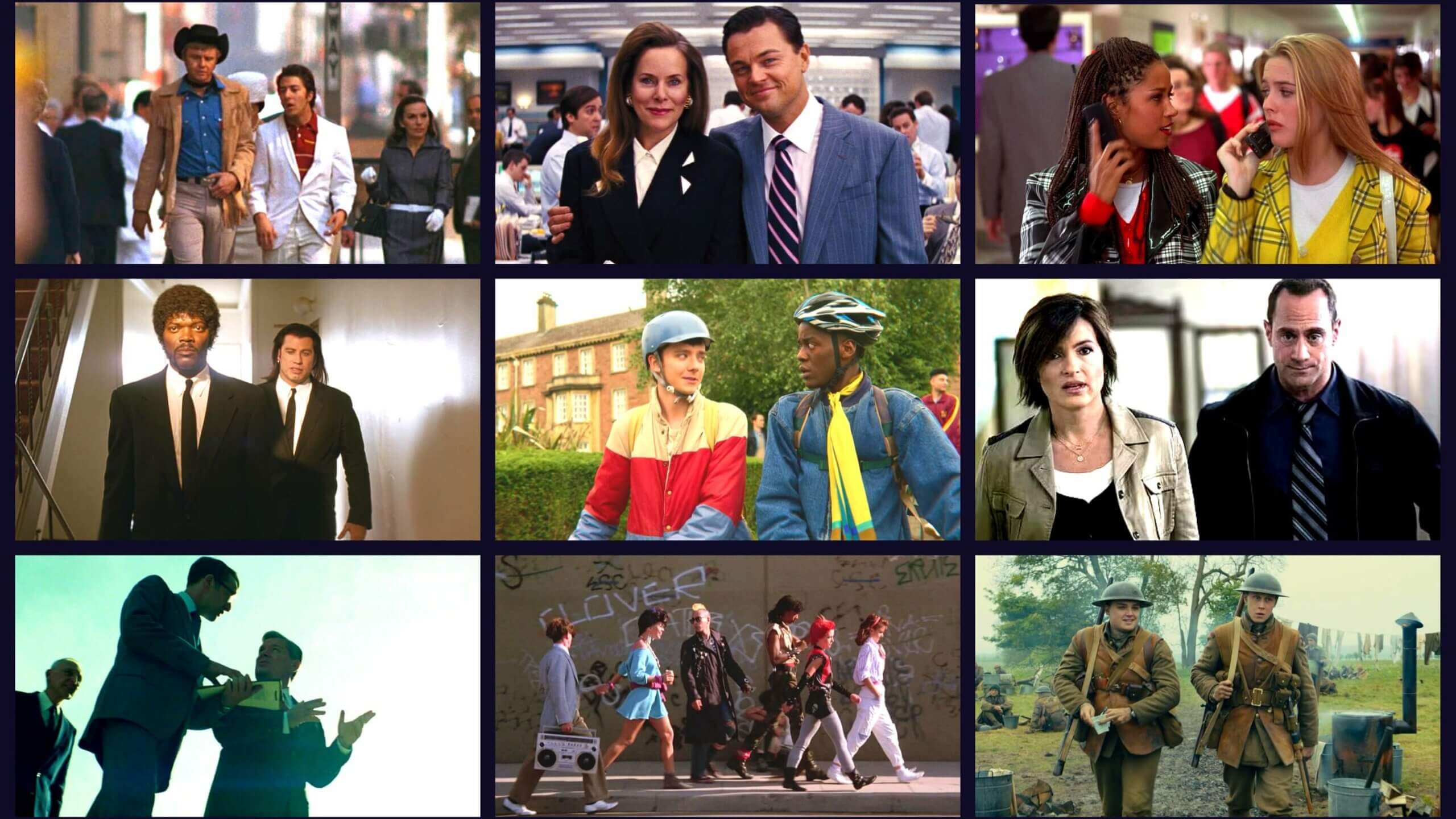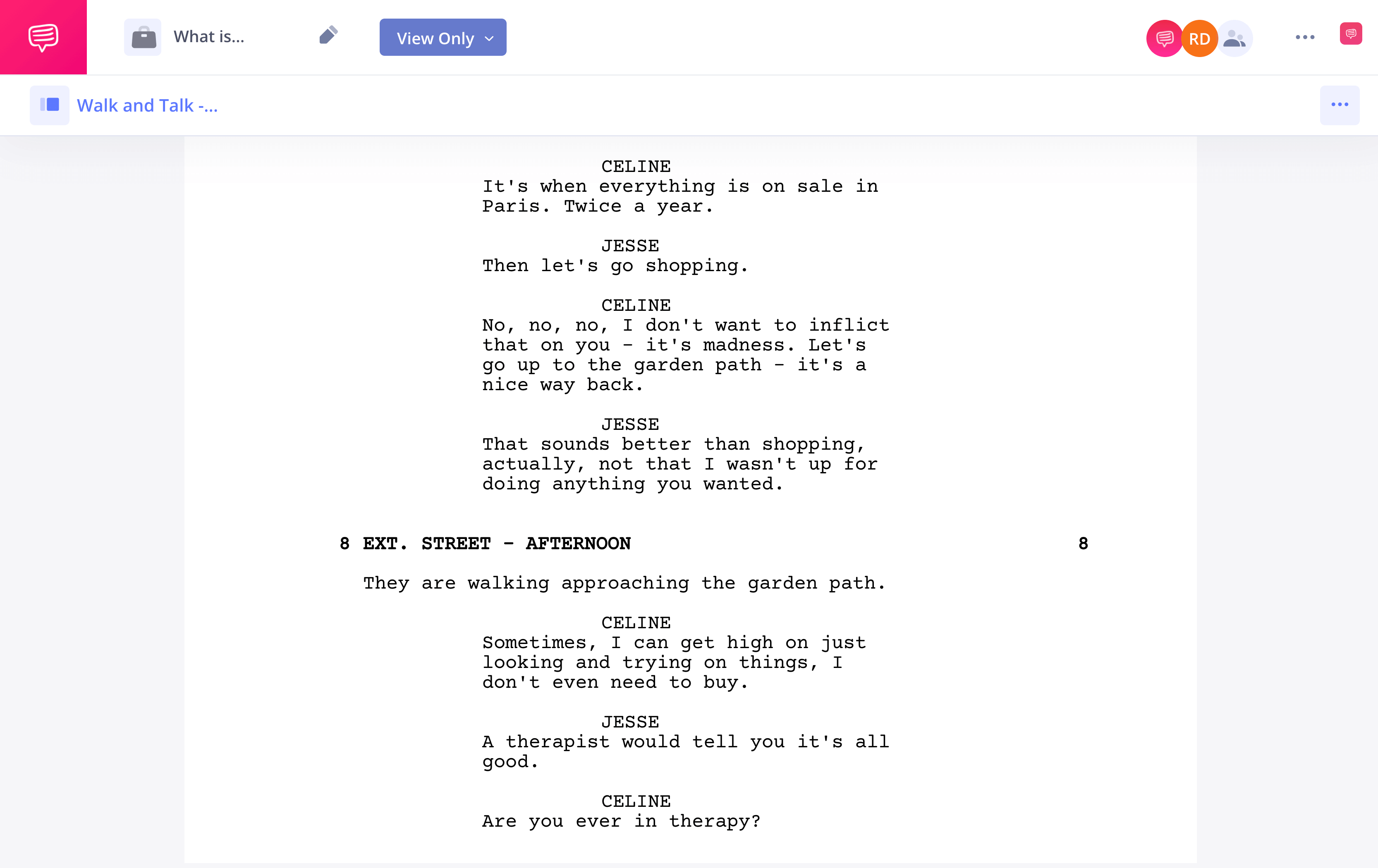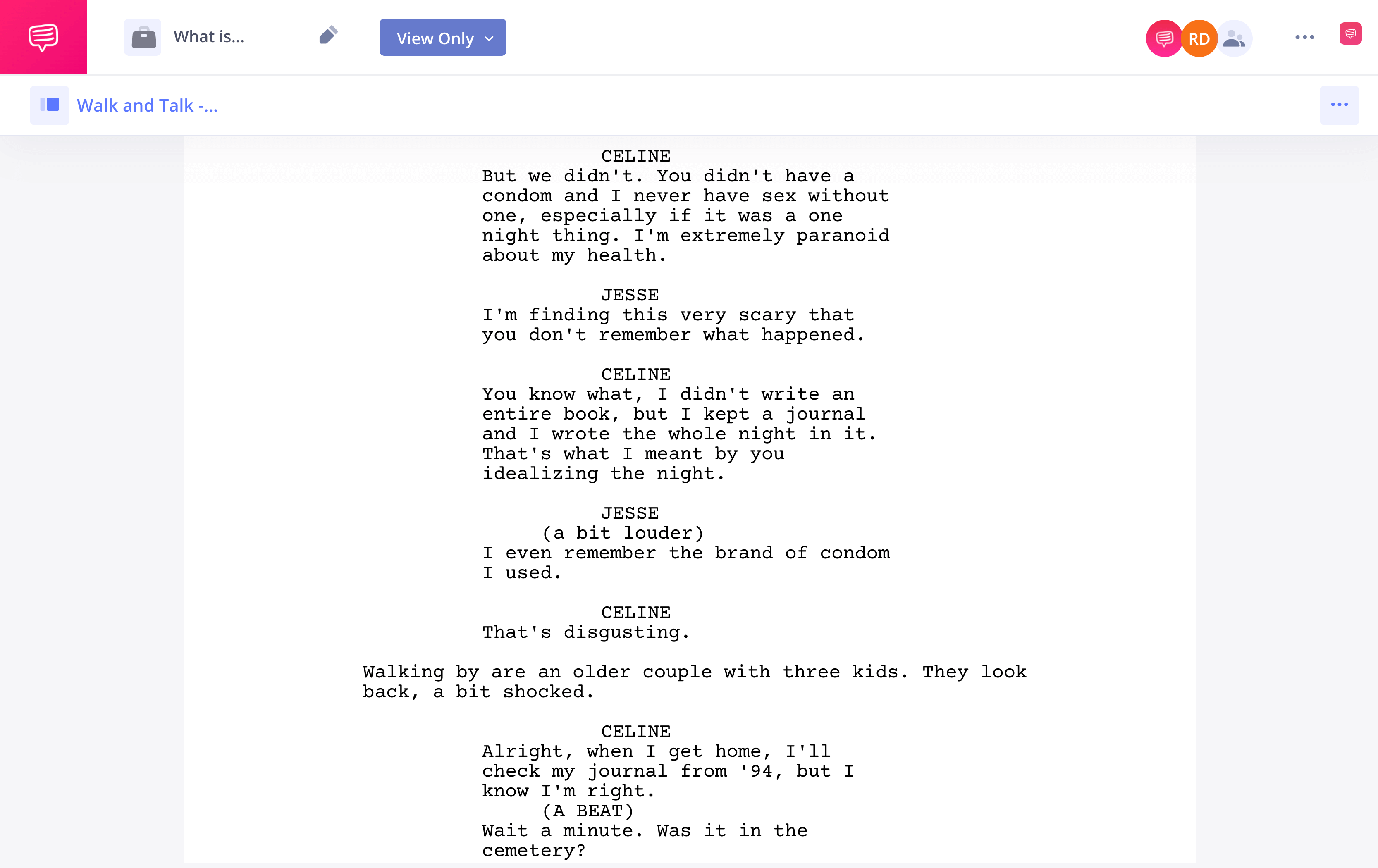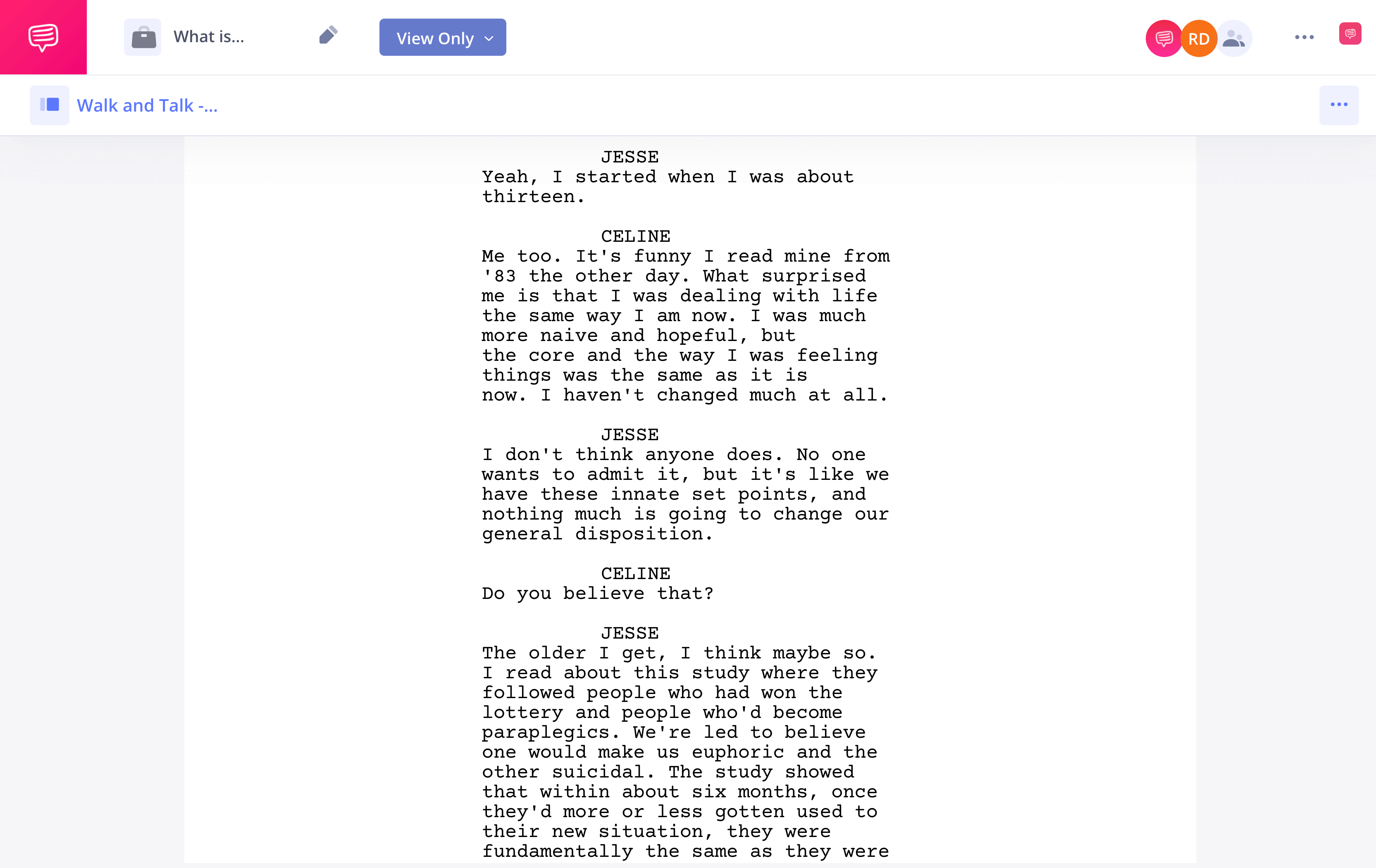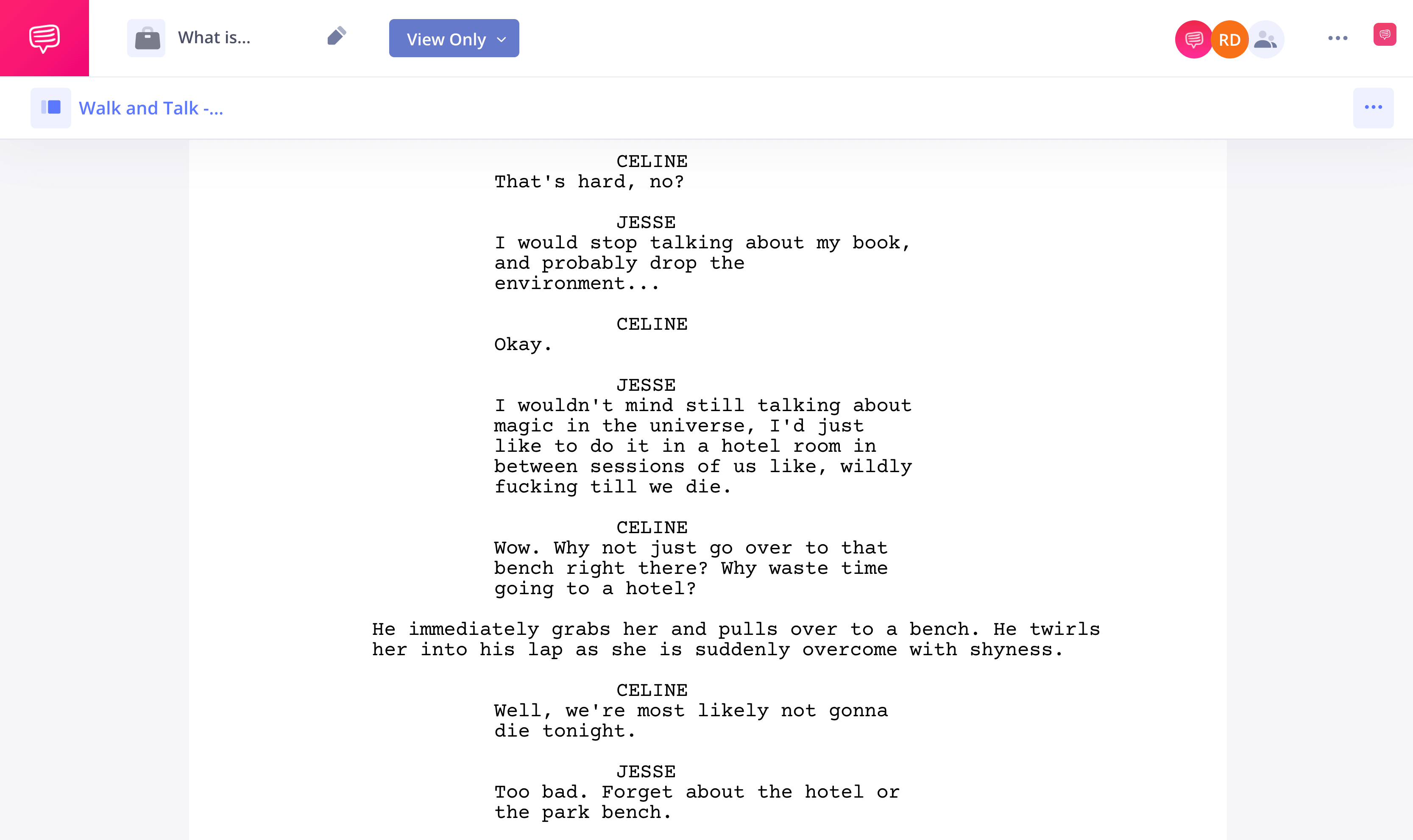Humans are multitaskers. We can listen to the news while doing dishes; we can pat our heads and rub our stomachs; and we can walk and talk. Humans in movies and TV especially love to do the last option. The walk and talk is a strategy used by directors in countless shows and films. Let’s look at how the walk and talk works, where it shows up, and why you may want to use it.
Walk and talk meaning
The Walk and Talk Explained
The walk and talk has become a much referenced and talked about term. But in case you don’t know– let’s define the phrase. What does the walk and talk refer to?
WALK AND TALK DEFINITION
What is a walk and talk?
A walk and talk is a filmmaking technique where characters have a conversation while walking. Beyond this simple criteria, a walk and talk can take many forms. It may be a character talking to themselves, to the camera, to another character, or several other characters.
The camera, meanwhile, can track with the character, stay stationary, or pan. All that matters is that there is talking and walking.
Considerations for a walk and talk
- Setting– where are they walking to and from?
- Dialogue– what are they talking about?
- Camera movement– how is the camera moving?
- Blocking– how are the actors moving?
Walk and talk film uses
Why use a walk and talk?
A walk and talk can serve a variety of purposes. But no matter what, it adds energy. Having your characters moving while they talk rather than sitting or standing in a single space will create a visual dynamism that otherwise wouldn’t be there. As we’ll see, that can be useful for filmmakers.
But it also means that walk and talks should be used deliberately. A quiet and emotional conversation may be diluted by the energy the technique brings.
With that in mind, let’s go through some of the reasons to use a walk and talk.
Exposition
Emotional heart-to-heart conversations may not be great for a walk and talk, but exposition is. This is dialogue which lays out background information that an audience needs to know. When there’s a lot of exposition to get through, it can bog down a scene, and the audience may even become aware of it.
Delivering exposition through a walk and talk is a tried-and-true method to distract from dry dialogue. Even though characters may be talking about things that lack drama, their movement gives their conversation energy and urgency.
Emphasize busy
Another common use of the walk and talk is to emphasize how busy a character or characters are. They don’t have time to sit around and chat– they’re on the move from one task to the next.
Aaron Sorkin is famous for employing the walk and talk for this purpose. His scripts often follow overworked and stressed out people, so it’s only fitting that they’re constantly in the midst of going somewhere in a hurry.
Introduce setting
A stroll and gab is also great for a sort of visual exposition. As the characters make their way through a setting, so does the audience. Thus, by the end of the conversation, the location can be well established– we know where things are in relation to each other.
Get from A to B
Relatedly, a walk and talk is an effective way to get characters from one location to another. Instead of having the conversants in one spot and then cutting to them in another spot, just have them walk there.
This is especially true if you want to build anticipation for the second location. Maybe a character is even delivering exposition on the location before they arrive.
Related Posts
Walk and talk film
Walk and talk examples
The walk and talk’s utility means that it can be found everywhere in film and television. Let’s take a look at some of the more famous examples.
The West Wing
West Wing walk and talk
Aaron Sorkin has used the walk and talk countless times, both before The West Wing (Sports Night) and after (Studio 60 on the Sunset Strip). But it is The West Wing where the Sorkin walk and talk reached its zenith, with episodes largely comprised of different high-strung staffers marching around rattling off quips to one another.
The technique was used so much in the show that you can’t mention the walk and talk now without thinking of West Wing.
Birdman
Stepping and chatting in Birdman
Walk and talks are often prevalent in movies with long takes, since movement can disguise a lack of cutting. Few movies have longer takes than Birdman, and so it should come as no surprise that ambulating and conversing abounds in Alejandro González Iñárritu’s film.
Of course, there are other movies that pride themselves on simulating a oner for the entire runtime, like 1917, but none are quite as walky and talky as Birdman.
30 Rock
30 Rock and talk
Tina Fey’s celebrated show has its fair share of walk and talks, but none as famous as the stroll and chat with none other than Aaron Sorkin himself. Of course, the characters have to address that the technique is being used. It’s a standout meta-joke in a show that’s full of them.
Before Trilogy
Before Sunrise "Romantic Projections"
Richard Linklater’s Before trilogy is a testament to the beauty of the walk and talk. In each of the films, Linklater makes full use of what the technique can do. He uses the long tracking shots to show off gorgeous European settings, while having his characters talk with passion about love, life, and everything in between.
As you can see in the above clip from Before Sunrise, the end result is everything you could want out of a walk and talk.
So say you’re convinced of the power of the walk and talk. How do you write it out?
Walking the walk, talking the talk
How to write a walk and talk
Despite looking visually quite different from sedentary conversations, walk and talks on the page look relatively similar to their other back-and-forth counterparts.
At its core, a walk and talk is a conversation. In other words, it is dialogue-centric, so make sure your dialogue is good. What the characters are saying should be necessary, believable, and engaging– just like it should be in any other scene.
But of course, there’s the other element. Let’s go through the steps of laying out a walk and talk using Richard Linklater’s script for Before Sunset, which we imported into StudioBinder’s screenwriting software.
1. Add a scene heading
Like with any other scene, you’ll want to include a scene heading. Where are these characters walking?
If they’re walking far, you may need to include multiple scene headings as they go from location to location. Remember, this doesn’t mean you’re cutting, it just means the characters have walked into a new space. Note how Linklater uses this in Before Sunset:
Before Sunset script
Linklater doesn’t spend any time describing the street. This makes the conversation feel more continuous.
2. Write out the action
Of course, for the reader to know that your characters are walking, you need to note that. You should also add action lines if anything your characters walk by is important to their conversation or the scene generally.
Linklater uses an action break as a punchline:
Before Sunset screenplay
3. Let dialogue be the focus
Once you indicate that your characters are walking, there’s no need to reiterate it. Let the conversation take the forefront, and use action lines sparingly. Linklater lets pages go by without any scene description.
How to write a walk and talk
4. Note blocking
Blocking is a crucial component of the walk and talk, and while you can let the director decide on most of the specifics, you should call out any moments where blocking is important.
Does a character slow down because what they’re saying is sensitive? Do they turn a corner to see a beautiful vista? These are all things to note.
As Linklater shows us, blocking can be as simple as when the characters stop walking.
Walk and talk blocking
The walk and talk can take countless forms and serve a multitude of purposes. If a conversation is feeling stagnant, or visuals are looking samey, you may want to employ the technique.
Up Next
What is the Dolly Shot?
We've explored the intricacies of the Walk and Talk technique, and now it's important to remember that it's just one of many creative camera techniques employed by filmmakers to tell their stories. In our next article, we will delve into the dolly shot.
